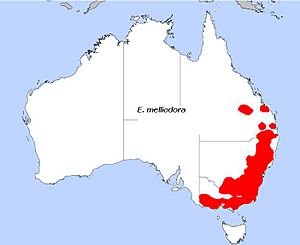Yellow box facts for kids
Quick facts for kids Yellow box |
|
|---|---|
 |
|
| Eucalyptus melliodora, flowers & leaves | |
| Scientific classification | |
| Genus: |
Eucalyptus
|
| Species: |
melliodora
|
 |
|
| E. melliodora, field distribution | |
The Yellow Box (scientific name: Eucalyptus melliodora) is a special tree found only in south-eastern Australia. People also call it Honey Box or Yellow Ironbark. It's usually a medium-sized tree, but sometimes it can grow very tall. This tree has rough bark on its trunk, which can be flaky or stringy. Higher up, the bark is smooth and looks grey or yellowish. Its grown-up leaves are shaped like a spear or an egg. The tree's flower buds grow in groups of seven, and its fruit looks like a half-sphere.
Contents
What the Yellow Box Looks Like
The Yellow Box tree usually grows up to 30 meters (about 98 feet) tall. It has a special woody lump at its base called a lignotuber. This helps the tree regrow if it gets damaged.
The bark on the trunk can be different. It might be smooth with a short, rough part at the bottom. Or, it might cover most of the trunk and be rough, thick, and dark brown or black. The smooth bark on the upper branches peels off, showing a white or yellowish surface underneath.
Young Yellow Box plants have leaves that are shaped like a spear or an oval. These leaves are about 2.5 to 6.5 centimeters (1 to 2.5 inches) long and 0.9 to 3.5 centimeters (0.3 to 1.4 inches) wide. They have a small stem called a petiole.
The leaves on older trees are a dull light green or grey on both sides. They are shaped like a spear or an egg, about 6 to 14 centimeters (2.4 to 5.5 inches) long and 0.8 to 3 centimeters (0.3 to 1.2 inches) wide. Their petioles are 0.8 to 2 centimeters (0.3 to 0.8 inches) long. A special vein on the edge of the leaf is far from the actual leaf edge.
The flower buds grow in groups of seven. They are on a stem called a peduncle, which is 3 to 10 millimeters (0.1 to 0.4 inches) long. Each individual bud has its own tiny stem, called a pedicel, which is 2 to 10 millimeters (0.1 to 0.4 inches) long. When the buds are ready, they look like a club, an oval, or a diamond. They are 4 to 8 millimeters (0.2 to 0.3 inches) long and 3 to 5 millimeters (0.1 to 0.2 inches) wide. They have a cap, called an operculum, which can be cone-shaped or rounded.
Yellow Box trees can flower almost any time of the year, and their flowers are white. The fruit is a woody, round capsule, about 3 to 8 millimeters (0.1 to 0.3 inches) long and 3 to 7 millimeters (0.1 to 0.3 inches) wide. The seeds are inside this capsule.
How the Yellow Box Got Its Name
The Yellow Box tree was first officially described in 1843. A botanist named Johannes Conrad Schauer wrote about it. He used notes from another botanist, Allan Cunningham, who had described it earlier but hadn't published his work. Schauer's description was then put into a book by Walper.
Where the Yellow Box Lives
The Yellow Box tree grows in many places across eastern Australia. You can find it on the plains and tablelands. It grows in western Victoria, throughout New South Wales, and up into south-central Queensland. It also grows around Canberra, Australia's capital city.
Yellow Box in Nature
The Yellow Box often grows near other types of trees. These include the Inland Grey Box, Fuzzy Box (E. conica), White Box (E. albens), and Pilliga Grey Box (E. pilligaensis). It also grows with Red Ironbark (E. sideroxylon), Narrow-leaved Ironbark (E. crebra), and Blakely's Red Gum (E. blakelyi). You might also see it with Apple species (Angophora), Black Cypress (Callitris endlicheri), White Cypress (Callitris glaucophylla), Kurrajong (Brachychiton populneus), and different types of Wattles (Acacia).
Uses of the Yellow Box Tree
The Yellow Box tree is very useful! Its wood makes good firewood. It also provides strong, hard, and long-lasting timber for building.
One of the most famous things about the Yellow Box is its honey. Bees love the flowers of this tree, and the honey they make from it is known for being very high quality and delicious.
Famous Yellow Box Trees
A very special Yellow Box tree survived the atomic bomb blast in Hiroshima, Japan, on August 6, 1945. This tree was only about 740 meters (about 2,428 feet) away from where the bomb exploded. Even after such a terrible event, the tree was still standing in April 2019! It's one of the few trees, called Hibakujumoku, that survived the blast.
Gallery
-
E. melliodora in Wagga Wagga
See also
 In Spanish: Boj amarillo para niños
In Spanish: Boj amarillo para niños







